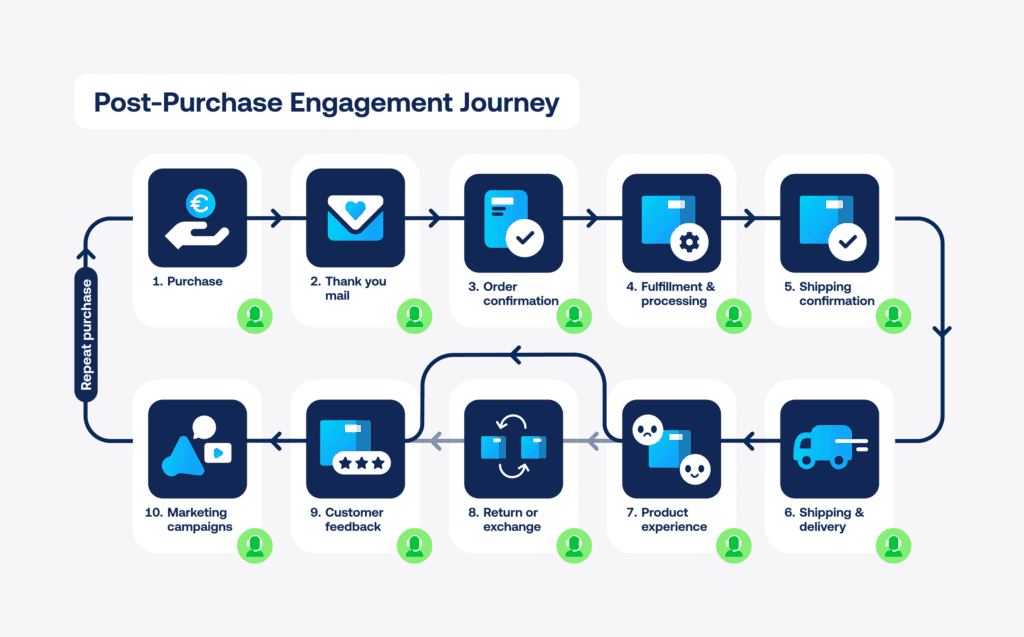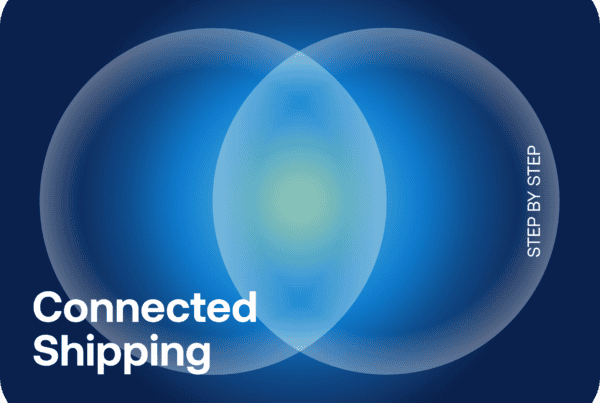Picture this: A customer just clicked “buy” on your site. They’re excited, expecting their order to arrive soon, but what happens next? The journey doesn’t end at checkout—it’s just beginning. The so-called post-purchase experience is where loyalty is made. If you’re letting your customers drift away after they hit “buy”, you’re missing the most valuable part of the journey.
Here’s the hard truth: It costs 5x more to attract new customers than to retain existing ones. Yet, so many brands still overlook the critical post-purchase phase, risking churn and missed opportunities.
Want to turn one-time buyers into lifelong fans? In this guide, we’ll show you how to make every post-purchase interaction unforgettable, transforming a simple sale into lasting loyalty. Let’s dive in and redefine what happens after the sale.
Table of contents
- Post-purchase definition
- The impact of post-purchase for e-commerce brands
- Best practices to improve the post-purchase phase
- How to measure your after-sales success
- Real-world examples of post-purchase success
- Post-purchase experience software
- Conclusion
- Post-purchase FAQ
Post-purchase definition
The post-purchase experience refers to all interactions a customer has with an e-commerce brand after completing a purchase. It goes beyond the initial transaction, covering follow-up communication, order tracking, delivery, returns, and customer support. A well-managed post-purchase experience makes sure customers feel valued and supported, setting the stage for long-term loyalty and repeat business.
What does the post-purchase customer journey look like?
The post-purchase customer journey maps out the specific stages and touchpoints a customer goes through after a purchase:
- Starting with order confirmation,
- it further includes receiving shipping updates,
- tracking the package,
- experiencing the packaging and the product,
- and possibly making returns or exchanges.
Each stage in this journey shapes how the customer perceives the brand and impacts their likelihood of returning. A seamless, well-designed journey reduces friction, improves satisfaction, and turns one-time buyers into loyal customers.
What is post-purchase behavior?
Who doesn’t know the feeling of waiting endlessly for an order, only to be met with confusion or frustration when things don’t go as planned? It sucks, right? That’s why post-purchase behavior—the way customers feel and react after making a purchase—is critical for brands to understand.
It includes:
- whether they are happy with the product,
- whether they decide to return it,
- or if they experience post-purchase dissonance or buyer’s remorse.
This behavior is often shaped by factors like receiving shipping updates, engaging with support, or the ease of returning a product.
Positive post-purchase behavior, such as repeat purchases or positive recommendations, signals a successful post-purchase experience and strong customer satisfaction.

The impact of a smooth post-purchase experience for e-commerce brands
Today’s shoppers expect smooth, stress-free service long after they’ve clicked “buy.” The post-purchase experience is no longer just a nice-to-have—it’s a business essential. It’s where loyalty is built, and the costs of poor service can hit hard. Here’s why it matters:
- Increase customer retention for better cost efficiency: Harvard Business Review reports that acquiring a new customer can cost five to 25 times more than retaining an existing one. And improving customer retention by even 5% can boost profits by up to 95%.
- Encourage positive word-of-mouth: A positive post-purchase experience can turn satisfied customers into vocal supporters. When customers feel valued, they are 71% more likely to recommend a brand to others (Motista). This word-of-mouth marketing is cost-free and can bring in new customers while increasing brand awareness.
- Excellent support improves loyalty: Customers who experience smooth post-purchase service are more likely to remain loyal. According to HubSpot, 93% of customers are likely to make repeat purchases with companies that provide excellent customer service. Brands that build an emotional connection with their customers can achieve a 306% higher lifetime value.
- Reduce return rates: Alaiko’s study found that 92% of shoppers would buy from a store again if the returns process was smooth, showing how even returns can play a role in customer loyalty.
- Higher operational efficiency: Optimizing post-purchase processes—such as order tracking and automated support—can make operations more efficient. By reducing manual tasks and providing transparency, brands can increase customer satisfaction while reducing internal costs.
Yet, many brands overlook this stage, missing the opportunity to set themselves apart from competitors who overlook these details. Tackling the following post-purchase pain points allows you to build stronger customer relationships and brand reputation.
The post-purchase process comes with its own set of challenges
- Lack of communication: Failure to communicate clearly about order status, delays, or issues can cause frustration and confusion.
- Unexpected costs: Hidden fees or unexpected charges that appear after the purchase can lead to customer dissatisfaction.
- Lack of visibility: With multiple carriers involved, accurate tracking can be hard to offer.
- Unreliable customer support: Slow or unhelpful customer service responses during the post-purchase phase can hurt a brand’s reputation.
- Bad packaging: Poor-quality or inadequate packaging can result in damage during transit, creating a negative experience for the customer.
- Complicated returns: A confusing return process risks turning customers away permanently.

8 best practices for a better post-purchase experience
A seamless post-purchase experience starts with laying a solid foundation during the checkout process and continues with clear communication, personalized touches, and efficient support. Here’s how you can make every step count:
1. E-commerce checkout optimization: Setting the foundation for a smooth post-purchase experience
The checkout process is the first crucial step in the post-purchase experience. A user-friendly, intuitive checkout ensures customers don’t face barriers that might lead to frustration or even shopping cart abandonment.
By optimizing the checkout flow and offering clarity on shipping costs and convenient options like guest-checkout and fast page loading times, you can help customers feel more confident about finalizing their purchase.
In this blog you’ll learn more about how to optimize your checkout to improve conversion rates and the overall shopping experience.
2. Building brand loyalty through memorable packaging
Packaging is a small but powerful touchpoint that can leave a lasting impression on customers. Thoughtful packaging that’s not only attractive but functional can enhance the unboxing experience. From eco-friendly materials to handwritten, personalized thank-you notes, it’s these details that can turn a one-time shopper into a loyal customer.
3. Keeping customers informed and engaged through outstanding post-purchase communication
Ever waited for a package and felt like it disappeared into a black hole? Don’t let your customers experience that! Once the order is placed, you have to keep the connection alive.
Good communication after the purchase shows customers that you care and keeps them engaged with your brand well beyond the sale. Here are a few pointers you should consider when communicating post purchase:
Thank you page and post-purchase emails: Strengthening connection and loyalty
A thank you page and well-crafted post-purchase emails go a long way in showing appreciation. Use this space to thank your customers for their purchase, offer recommendations, and provide relevant resources, like how-to guides or care instructions. This keeps customers engaged and builds a sense of connection right after the sale.
Transparency: Setting clear expectations from purchase to delivery
Nobody likes surprises when it comes to shipping—especially not the frustrating kind. Make sure your customers know what to expect:
- shipping times,
- potential delays,
- and how to track their order.
Clear communication sets expectations and helps build trust, ensuring they feel in control of their purchase.
Also, managing multiple carriers can make tracking a headache, but with automated updates and Shipping Intelligence, you can take the power back and provide a seamless tracking experience. Customers will appreciate the transparency and feel reassured knowing exactly where their order is. Read on to learn more about it!
4. Personalization: Building a more personalized customer experience
Everyone likes to feel special—and that includes your customers. Customers don’t just want a generic “thank you” email—they want to feel like you know them. Personalization based on your customer data makes a huge difference in post-purchase communication.
Tailor your follow-ups, emails, and even packaging to the customer’s preferences, and suddenly, they’re not just another sale—they’re a part of your brand’s story. Show them you care, and they’ll remember you next time they need something.
5. Boost the post-purchase experience through great customer support & automation
Great customer support is essential for resolving issues and keeping customers happy post-purchase. Whether it’s answering shipping questions, assisting with product use, or handling returns, effective support builds trust and loyalty. Make sure your team is easy to reach and equipped to resolve issues quickly and effectively!
WISMO reduction through automation
Nobody wants to hear “Where is my order?” (WISMO). By automating order tracking, you can send real-time updates that keep customers informed without them needing to ask. This reduces frustration and makes them feel valued, boosting their satisfaction.
You can even take it further with Shipping Intelligence: predict delays, estimate accurate delivery times, and send automatic alerts for any incidents. Staying ahead of potential problems means fewer WISMO inquiries and gives your support team more time for other important tasks.
With Shipping Intelligence, you’re not just reacting to issues—you’re anticipating them and solving problems before they arise! The outcome? A smoother experience that builds trust, reduces frustration, and encourages repeat business.
Learn how to optimize order tracking in our latest blog!

6. Transforming returns into a retention opportunity
Returns can be a headache for both brands and customers, but with the right strategy, they can also become an opportunity to strengthen customer loyalty:
- Make the return process as easy as possible,
- provide clear instructions,
- and use it as a chance to offer additional products, discounts, or personalized recommendations for their next purchase.
Find out more about the surprising role of returns in the post-purchase experience here.
7. Creating re-engagement opportunities post-purchase
Don’t let the relationship end once the order is complete. Use post-purchase interactions as an opportunity to re-engage customers. Offer discounts on future purchases, create loyalty programs, or send personalized product recommendations based on their previous purchase.
These efforts help bring customers back, increasing the likelihood of repeat purchases.
8. Gathering feedback and reviews for continuous improvement
The post-purchase stage is the perfect opportunity to gather feedback and insights. Encourage customers to leave reviews, share their thoughts on their experience, and provide suggestions for improvement. This not only helps you improve but also shows customers that you value their opinion.
Check out our blog on how to ask customers for reviews!
How to measure your post-purchase experience success
Measuring the success of your post-purchase experience is key to ensuring that your efforts are paying off. It’s not just about making customers happy—it’s about building loyalty, increasing retention, and driving long-term growth. Here’s what to track and how to measure your success.
Key post-purchase metrics to track
| Metric | What it measures | How to measure It | Tools |
|---|---|---|---|
| Repeat Purchase Rate | Indicates customer loyalty and whether they return for more. | (Number of customers who made multiple purchases / Total number of customers) x 100 | Google Analytics, Sendcloud, Customer.io |
| Customer Satisfaction (CSAT) | Measures overall satisfaction with the purchase and delivery experience. | (Sum of customer satisfaction scores / Total number of responses) x 100 | SurveyMonkey, NPS surveys, Google Forms |
| Return Rate | Measures how often customers return products. | (Number of returned items / Total items sold) x 100 | Return portals (like Sendcloud), Google Analytics |
Successful real-world post-purchase examples
While every e-commerce business is unique, certain strategies have proven effective in improving the post-purchase experience. Let’s take a look at a few brands that have successfully turned their post-purchase process into a key driver of customer loyalty and satisfaction:
XXL Nutrition cuts WISMO calls and reduces cart abandonment
XXL Nutrition, the largest sports nutrition brand in the Netherlands and Belgium, reduced cart abandonment with same-day delivery and tailored checkout options, increasing conversions by 3%.
By automating the post-purchase process, they cut down on WISMO calls, boosting annual revenue by 40% and shipping 28% more parcels. This focus keeps customers engaged with their fitness goals, not on their order status.

Pittarosso: Elevating the shoe post-purchase experience
Italy’s top footwear brand, Pittarosso, has mastered the art of keeping customers loyal well after purchase. Their strategy focuses on:
- Multiple delivery options to give customers flexible choices through a variety of carriers.
- A simple return portal that allows customers to return items with just a few clicks.
- Personalized tracking emails to keep customers informed and engaged after their purchase.
“Speed is key in both a fast website and a smooth, enjoyable shopping experience. We aim to make every step easy for the customer—from purchase to delivery to returns,” says Digital Manager Pietro Rossato.
This attention to detail in the post-purchase journey has helped Pittarosso build lasting relationships with their customers, making each interaction seamless and satisfying.
Boots’ success in creating re-engagement opportunities post-purchase
Health and beauty retailer Boots transformed tracking emails into touchpoints for upselling and brand reinforcement, using branded messages that offer shipment updates alongside promotions and recommendations.
Enhanced post-purchase communication led to higher customer satisfaction, reducing WISMO questions and strengthening Boots’ connection with its customers.

These examples show that a thoughtful and well-executed post-purchase strategy not only improves customer satisfaction but also drives long-term retention.
The key takeaway? You don’t need to reinvent the wheel—just focus on keeping your customers informed, engaged, and valued.
Maximizing customer satisfaction beyond the sale with software
Don’t worry, you don’t have to apply best practices and examples on your own. With the right tools, improving customer satisfaction beyond the sale becomes much easier. So called post-purchase experience software is designed to optimize the journey your customers take after hitting “purchase.” By automating processes and providing real-time updates, this software ensures your customers stay informed and engaged long after they’ve made a purchase.
It can also help reduce customer inquiries, enhance transparency, and turn potential issues into opportunities for loyalty. Ultimately, it frees up your team, improves operational efficiency, and leaves your customers with a seamless, stress-free post-purchase experience.
Wrapping up: The power of a great post-purchase experience
Creating a great post-purchase experience is more than just good customer service—it’s a strategic way to build loyalty, reduce friction, and turn a one-time customer into a repeat buyer. With the right tools and strategies you can offer customers a seamless experience that goes beyond the sale.
At Sendcloud, we understand the importance of post-purchase satisfaction, which is why we offer powerful tracking and returns solutions that help you stay connected with customers every step of the way. With our intuitive platform, you can provide real-time tracking updates, optimize your returns process, and improve customer satisfaction—all from one place.
Ready to take your post-purchase experience to the next level? Learn more about Sendcloud’s post-purchase experience software for e-commerce!
Post-purchase experience FAQ
What is the post purchase experience?
The post-purchase experience is the journey customers go through after they make a purchase. It includes everything from order confirmation, tracking, and delivery updates to follow-up emails, returns, and requests for feedback.
Why is post-purchase important for e-commerce?
The post-purchase phase is crucial because it shapes how customers feel about your brand. Positive experiences lead to loyalty and repeat business, while negative ones can lead to returns or lost customers.
What is post-purchase behavior?
Post-purchase behavior is how customers act and feel after they’ve received their order. This includes satisfaction levels, likelihood to make another purchase, leave a review, or recommend your brand to others.
How does the post purchase customer journey look like?
The journey typically starts with order confirmation, followed by tracking updates, delivery, and finally post-delivery engagement, such as emails, support, or returns. Each step aims to build trust and keep the customer connected with your brand.
What is the best post-purchase experience software?
There are many great options, like Sendcloud, which automates tracking, updates, and returns, helping businesses keep customers informed and satisfied throughout the whole post-purchase journey.
















